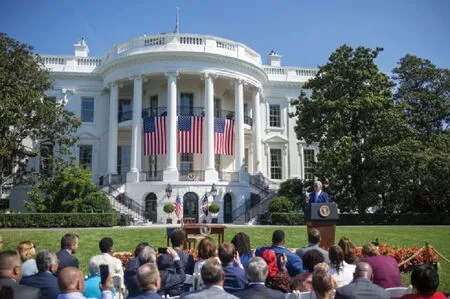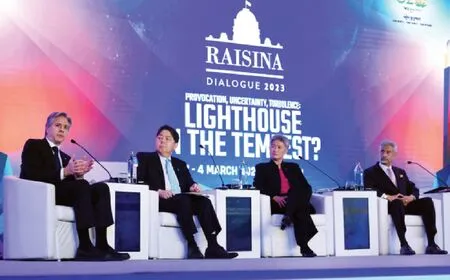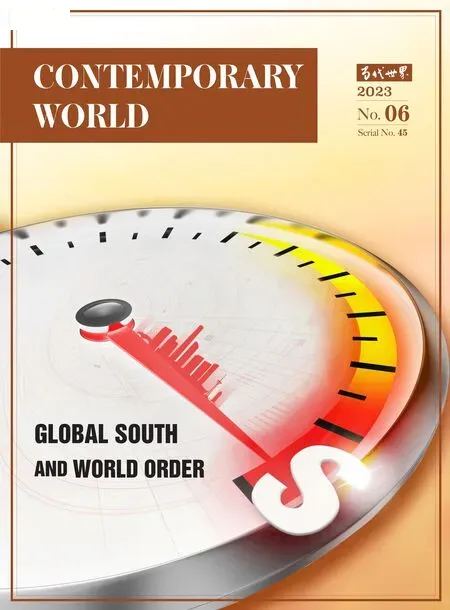US Strategic Competition with China and the Evolution of Order in the Asia-Pacific Region
Gao Cheng
As the international order dominated by the US hegemony is being challenged, the United States has been making great efforts to strategically suppress China in the Asia-Pacific region, attempting to build a regional order framework underpinned by camp-based bloc politics, exclusive economic clubs,and Western-centered values-based alliances.
US POLICY TRENDS IN PRACTICING BLOC POLITICS IN THE ASIA-PACIFIC REGION
After the Trump administration’s National Security Strategy which positioned China as a strategic competitor,the Biden administration’s Interim National Security Strategic Guidance released in March 2021 further positioned China as the only country with the potential to compete with the US The US Indo-Pacific Strategy, released in February 2022, once again explicitly stated that most of the challenges facing the Indo-Pacific region come from China, and hence proposed that the US will strengthen its institutions with allies and strategic partners in the Indo-Pacific region in order to jointly respond to China’s rise.The contents of the strategy include ten actions covering military, trade and economy, supply chain, technology research and development, and cyberspace, among other areas.In the US National Security Strategy released in October of the same year, China is positioned as one of the global priorities and the only competitor with intent to reshape international order.Compared to the Trump administration’s Indo-Pacific Strategy, the Biden administration has emphasized the return of US leadership in the Indo-Pacific region, focusing on deepening and strengthening the network of allies and partnerships.It also encourages allies and strategic partners to strengthen their ties, and draws in outside allies to intervene in the Indo-Pacific region, binding security, politics, and economics with ideology to create an all-round bloc politics ecology to isolate and suppress China.
First, the US has vigorously strengthened its partnership with allies in the military and security fields.Through its military forces stationed in Japan, the Republic of Korea (ROK),Australia, the Philippines, it enhances the military ties with its allies.By establishing QUAD and AUKUS based on the Anglo-Saxon identity, the FVEY and other core alliance mechanisms,it has been gradually promoting comprehensive cooperation with its allies in military and security.By engaging in multi-line interaction with its core allies, building a US-led regional military security integration system,and frequently holding joint military exercises with China as the imaginary enemy, the US strives to strengthen the sense of identity between itself and its regional allies and partners.For emerging partners, the US has formed security partnerships through regular military contacts, institutionalized in defense cooperation of trade and technology, as well as in-depth security cooperation in logistical assistance, electronic communications,and information sharing.The US has adopted a layered approach, dividing ASEAN and focusing on roping in the Philippines, Indonesia and Vietnam.At the same time, the US encourages NATO and other major countries outside the region to intervene in Asia-Pacific affairs, pushes its European allies to pay attention to the situation in the Asia-Pacific region and the Taiwan Strait and actively intervene in Asia-Pacific affairs, increases its military presence in the South China Sea and the Taiwan Strait, and deepens the integration of the Eurasian alliance system.In addition, in June 2022, the US formed the Blue Pacific Partnership with Australia, Japan, New Zealand,and the U.K.This is the very first time that the Biden administration has built an alliance to counterbalance China in the Pacific Islands region.In March 2023, the US Department of Defense website released its defense budget for Fiscal Year 2024, which emphasized the priority of considering developing stronger relationships and cooperation with US partners and allies to address the China challenges in the Indo-Pacific region.On the occasion of the G7 summit in May 2023, the US invited India, Indonesia, Brazil, Vietnam, Australia, and the ROK to hold an expanded meeting in an attempt to further broaden its circle of allies.
Second, the US has established club-like exclusive mechanisms in the economic field with the goal of excluding China, weakening economic ties between its key allies and China, and ensuring US economic dominance in the Indo-Pacific region.In May 2022, Biden announced the launch of the Indo-Pacific Economic Framework during his visit to Japan,declaring that the 14 member states had almost completed negotiations on an agreement to improve supply chain resilience and security, in which the supply chains for essential materials, such as chips and key minerals, will be strengthened in order to reduce reliance on China.In July 2022, US Secretary of the Treasury Janet Yellen, during her visit to the ROK, strongly promoted the concept of friend-shoring.It seeks to break through the spatial and temporal limitations of supply chain cooperation, which will no longer be limited to Mexico and other US neighboring countries, but will further include all US allies with the so-called common values in areas like Latin America, East Asia, and South Asia.In September 2022, Biden signed an executive order proposing a special assessment of the national security risks posed by investors from rival or hostile countries, accelerating the implementation of friend-shoring and small yard with high walls policies.In March 2023, the US and its major allies gradually reached a consensus on the issue of de-risking from China,proposing the creation of a so-called diversified and resilient supply chain as an important part of the de-risking strategy towards China, and further stepping up the promotion of friendshoring and near-shoring.
Third, the US has strengthened its efforts to break the chain and block the flow of technology on China.In November 2021, Biden signed the Secure Equipment Act, which prohibits countries from supplying China with high-end semiconductor chips made with US tools anywhere in the world.In July 2022, the US forced the Netherlands to prohibit its chip lithography equipment makers from sellingkey chip manufacturing technologies to China.In August 2022, Biden signed the Chips and Science Act,which provides a total of $280 billion of investment for five years, while restricting subsidized firms from expanding high-tech investments in China and limiting their ability to help China expand its semiconductor capacity.In October 2022, the US Department of Commerce introduced a new ban on semiconductors in China,restricting chip equipment manufacturers from exporting and investing in China, and brought together Japan, the ROK, and Taiwan to form the Chip 4 Alliance with the aim of building a high-tech network and supply chain that excludes China, and further encircling the development of the semiconductor industry in China.In January 2023, the US brought together Japan and the Netherlands to sign an agreement on expanding restrictions on China’s chip technology.In the field of cyberspace, the US has jointly launched the Declaration for the Future of the Internet with the EU, the UK, Australia and Japan in an attempt to constrain China by formulating new rules for the Internet.

Fourth, in the field of ideology, the US promotes the building of valuesbased alliances targeted at curbing China, with the intention of isolating China through economic, political and ideological binding.The US Indo-Pacific Strategy clearly states: Our objective is to shape the strategic environment in which China operates,building a balance of influence in the world that is maximally favorable to the United States, our allies and partners, and the interests and values we share.Specific means include: economically, hyping up China threat and striving to reconstruct the socalled free economic order dominated by the US in the Indo-Pacific region;politically, emphasizing the bond of common values between the US and its allies, and openly putting labels of authoritarian states and coercive diplomacy on major countries like China and Russia.In the US National Security Strategy report released in October 2022, the words democracy,freedom and values, which are closely related to ideology, were mentioned 182 times.This is a reflection of the US attempt to mold its competition with China into a bipolar confrontation between so-called democracy and authoritarianism and to push its allies to work with it to reshape the international rules for technology,cyber security as well as economy and trade, so as to encircle and contain China on all fronts.The Fiscal Year 2023 National Defense Authorization Act that Biden signed specifically mentioned China’s neighboring Southeast Asian countries, emphasizing the importance of deepening and broadening Southeast Asian alliances,partnerships, and multilateral interactions, and to expanding opportunities for ASEAN to work with other likeminded partners in the region.This is an attempt to undermine the close interaction between China and emerging market and developing countries,as well as regional integration and cooperation in East Asia, and to drive division and confrontation among countries in the Asia-Pacific region through the wedge strategy.
THE IMPACT OF US BLOC POLITICS ON THE ORDER IN THE ASIA-PACIFIC REGION
The current political and economic ecology of the Asia-Pacific region is clearly different from the Cold War order formed during the period of USSoviet rivalry, and it is unlikely that the old path of Cold War will be repeated.
First, there are no two opposing military alliances in the Asia-Pacific region today.On the one hand, due to China’s non-alignment policy, the Asia-Pacific region will not form a military alliance system dominated by China.On the other hand, it is difficult for the US to integrate its allies in the Asia-Pacific region through multilateral forms to jointly target China.Most of the US allies in the Asia-Pacific region tend to adopt a hedging strategy rather than following the US completely to check and balance China.Hence, it is difficult to form a NATO-style multilateral military alliance against China in the region.
Second, unlike the US-Soviet Cold War, the competitive side of China-US relations is not an arms race based on nuclear deterrence, but economic and technological competition.Since the implementation of the US policy of economic engagement with China,the economic interdependence between China and the US has risen markedly, and the two countries have a cooperative relationship in numerous areas.With the high degree of economic interdependence between China and the US and economic globalization, it is difficult for the Asia-Pacific region to form two parallel economic systems that were decoupled from each other like the ones during the Cold War.
Third, the differences between China and the US are mainly reflected in their development and governance models.The US uses the banner of Western democratic values to draw other countries together to isolate China, but the anti-communist alliance it hopes to create has not been formed.China has always pursued the greater good and shared interests in conducting international exchanges,which has been highly appreciated by most countries.
The nature of competition between China and the US in the Asia-Pacific region is different from that of the Cold War between the US and the Soviet Union.However, under the circumstances where the United States implements comprehensive preventive suppression against China, the Asia-Pacific region today is beginning to take the shape of an order of bloc politics, which is showing some kind of Cold War-like features.

U.S. Secretary of State Abraham Blinken, Japanese Minister for Foreign Affairs Yoshimasa Hayashi, Indian Minister for Foreign Affairs S. Jaishankar, and Australian Minister for Foreign Affairs Penny Wong attend a meeting of foreign ministers of the Quadrilateral Security Dialogue on March 3, 2023, in New Delhi, India.
First, although the Asia-Pacific region has not formed two major opposing military alliances, the US is creating a landscape of major country bloc politics in the region targeting at China.At present, it is increasingly prominent for regional competitive major countries and US Western allies to choose sides.India, a competitive regional major country, sees China as a potential strategic competitor, and has adjusted its diplomatic strategy of non-alignment 2.0, which is a careful balance strategy of maintaining strategic autonomy from the US and refraining from developing an alliance with the US, while at the same time maintaining a cooperative and competitive relationship with China.The strategy has now been adjusted to reaching out to the US to respond to China, by deepening cooperation with the US and actively participating in the Indo-Pacific Strategy to counterbalance China.
Second, due to the impact of a series of US policies, the degree of economic bonding and interdependence between China and the West has declined.In the context of trade friction between the US and China, although the industries of the two countries will not be fully decoupled, there will be a partial decoupling, especially in the high-tech field.In addition to the US and China’s industrial decoupling trend, the regional major countries are also worried about the security of the industrial supply chain.The major economies around China are either passively or actively reducing their dependence on the original global value chain, gradually shortening the industrial chain, and localizing and regionalizing the industrial chain.

On October 22, 2023, South Korea, the U.S. Air Force, and the Japan Air Self-Defense Force conducted their first joint air exercise over the vicinity of the Korean Peninsula.
Third, the cultural differences between China and the West, characterized by differences in development and governance models, have intensified.The growing influence of China’s development and governance model has made the US and Western countries deeply feel that the centuries-old monopolistic rule of Western civilization over the world has encountered unprecedented threats and challenges.With the escalation of its containment of China, the US has continued to emphasize that international political and economic cooperation should be based on common or similar values, in an attempt to realize the binding of political and economic security and ideology.
THE DIRECTION OF ORDER IN THE ASIA-PACIFIC REGION UNDER US STRATEGIC COMPETITION WITH CHINA
Under US coercion, there is a clear tendency for its key allies and regional major countries that are in strategic competition with China in the Indo-Pacific region to choose sides.At the same time, however, most countries in the Asia-Pacific region are striving to maintain their strategic independence and refusing to take sides, which is the basis for China to shape a favorable strategic environment for its neighbors and maintain a regional order based on the theme of peace and development in the region.
First, the overall situation in the Asia-Pacific region is that most countries tend to remain neutral rather than taking sides.Most countries in South Asia also maintain good relations with China under the Belt and Road Initiative.In East Asia, the DPRK and the US have long been at odds, and Mongolia has adopted a balancing strategy between China and the US In Southeast Asia, on the one hand, most Southeast Asian countries have adopted a hedging strategy between China and the US, seeking equidistant diplomacy.On the other hand, influenced by the historical lessons of colonialism and the US-Soviet Cold War, Southeast Asian countries do not want to once again become the arena of the major countries’games or be involved in proxy wars.Although faced with US pressure,most of the ASEAN countries did not follow the US containment of China,but tried hard to avoid choosing sides.
Second, the US has gradually lost its willingness and ability to provide economic engines and public goods in the field of governance in the Asia-Pacific region.In contrast, China’s contribution and status in the Asia-Pacific economic order have been on the rise in the process of rebuilding the industrial chain and value chain.In the face of setbacks in globalization and regional integration, the signing of RCEP against all odds marks the establishment of the world’s largest FTA, with China and ASEAN as the most active driving forces.RCEP provides an important platform for China to play a leading role in the economic governance in the Asia-Pacific region.
The East Asian economy has long relied on the European and American markets for final consumer goods,and has also long played the role of an intermediate market in the global and regional industrial chain.With the advancement of the highquality Belt and Road cooperation with neighboring countries, China’s market share of final products in the neighboring regions is also rising.As China’s market share of final products in the Asia-Pacific region rises,the level of economic cooperation between the economies in the region and China’s influence in neighboring countries will increase accordingly,and China will gradually replace the US to become the center of the economic order in the Asia Pacific region.
Last but not least, although the US is trying hard to create a small circle based on ideology to jointly suppress China, most countries in the Asia-Pacific region and even in the world today have no intention of joining the ideological confrontation camp, but are more concerned about how to establish a fair and equitable international order,as well as the contribution of major countries in the development model and global governance.With the decline of the demonstration effect of the Western development model in non-Western countries, the absence of US leadership in global governance and the ineffective functioning of the European Union in the face of the collective dilemma, more and more countries are skeptical of the so-called universal values and development path of the Western world, as well as the world order it dominates.If China increases its exchanges with these countries in development models, and at the same time provides more public goods in the field of global and regional governance for the world, especially the neighboring regions, and enable the majority of non-Western countries to have more confidence in the prosperity and stability of the world brought by China’s solutions to global governance, then the future world and Asia-Pacific order will not fall into the trap of bloc politics that the US is trying to build.

Workers on the production floor at the SAIC Motor Corporation’s automotive plant on September 7, 2023 in Chonburi Province, Thailand.
- Contemporary World的其它文章
- Global South: An Important Driving Force for the Evolution of the International Order
- New Developments in the Middle East amid Great Changes:Features, Challenges and Prospects
- US Democratic Party Campaign Strategy Adjustment under the Background of Political Polarization
- The Journey to Youth Creation on Shared Prosperity:Sharpening Mutual Learning for Shared Future for Humanity
- The Strength of the Global South in Addressing Climate Change
- Main Manifestations, Causes and Prospect of Leapfrog Development of China-Arab Relations in the New Era

